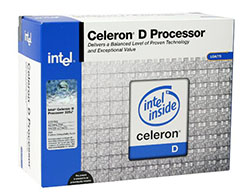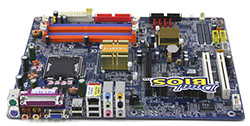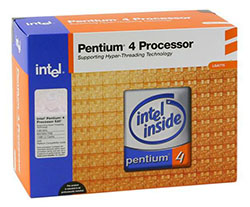Buyer's Guide - Entry Level to Mid-Range, March 2005
by Jarred Walton on March 15, 2005 1:30 PM EST- Posted in
- Guides
CPU and Motherboard: Intel
Unlike the AMD picture, where we have some real changes from our last Budget Guide, the Intel budget offerings are pretty much the same as last time. Considering the increased performance, lower power/heat requirements, and potential for 64-bit support that AMD offers, Intel doesn't really look that good. EM64T is only available starting at the $200+ processors, although we should start seeing some new Celeron D parts in Q2 that include EM64T. However, since we've switched from socket A in AMD-land, we'll ditch socket 478 in Intel-land as well. They're both being phased out rapidly these days, so we can't see advocating a purchase of a new system using a dying platform anymore.For a budget system, we're still looking primarily at Celeron D processors, as even the cheapest Pentium 4 chips will cost $150. (Certain socket 478 Pentium 4 chips are slightly cheaper, but again, we can't see recommending the 478 platform.) The motherboard chipset is a little harder to decide on, as you have 865 and 915 offerings to sort through. 865G/PE will cost less typically and allow you to use an AGP card, while 915G/P support PCI Express graphics cards. If you want integrated graphics, we'd go with an 865G motherboard, as the 915G boards are all rather expensive for a budget system. 865PE with a cheap AGP card would cost as much as most 915G boards (and generally perform better as well)! We're going to avoid the IGP options on socket 775 for this reason and go with 915P.
 |
 |
| Click images to enlarge. | |
Socket 775/T Motherboard: EPoX EP-5EPAJ 915P
Price: $82 shipped
Socket 775/T CPU: Intel Celeron D 325J 2.53 GHz 256K L2 Cache
Price: $84 shipped (Retail)
Total: $166
The best that we could come up with for a reasonable 775 system again uses an EPoX motherboard. Features are similar to the 8KDA3J that we used for our AMD system, only with an Intel chipset instead of an NVIDIA chipset. The hardware firewall is no longer present, of course, but gigabit Ethernet remains. Firewire support and HD audio are also missing. Remember that the 915 chipset is a PCI Express solution, so you will need a newer graphics card in order to use this motherboard. 915G motherboards will remove this requirement, but we suggest that you stick with the more expensive 915G as opposed to the 915GV/GL chipsets. See our alternative choice below.
Our processor of choice happens to be the cheapest (and slowest) option available for socket 775. It's not necessarily bad, of course, and for most tasks, it will perform well enough. Gaming is not one of those tasks, however, so if that's what you're after, go back to the AMD recommendations, please.
 |
 |
| Click images to enlarge. | |
Socket 775/T Motherboard Alternative: Gigabyte GA-8I915G Pro i915G
Price: $99 shipped
Socket 775/T CPU Alternative: Intel Pentium 4 520 2.8 GHz 1024K L2 Cache
Price: $152 shipped (Retail)
Total: $251
Our alternative upgrades to the base socket 775 recommendation uses a Gigabyte motherboard for its improved features. Among the additions are Azalia HD audio support and firewire ports, and we even get the integrated GMA-900 graphics as a bonus. Truth be told, you could use this motherboard as the "budget" option and skip the requirement for an add-in graphics card. The 915G and 915P chipsets are otherwise identical, so having the VGA port doesn't hurt, even if you never use it. The one area where the Gigabyte board may fall a little short is in overclocking support. If that's a real concern, the Abit AG8 is probably the next step up, but prices increase rapidly.
Our upgraded processor choice for Intel is once again their cheapest offering for socket 775; only this time, we've eliminated the Celeron from contention. That leaves us with the Pentium 4 520J, and the price is unchanged from our last budget Guide. At 2.8 GHz, the Pentium 4 is typically slower than any of the Athlon 64 processors. Of course, Intel still does a little better in a few applications like video encoding, provided that they have proper optimizations for the architecture. This is the bare minimum Intel P4 system with PCI Express support, though, and most people will be satisfied with the performance.










59 Comments
View All Comments
JarredWalton - Monday, June 13, 2005 - link
58 - ??? The Mid-Range to High-End went up a couple weeks ago. Next update in a couple more weeks, I guess. :Dhttp://www.anandtech.com/guides/showdoc.aspx?i=242...
SAV602 - Thursday, June 9, 2005 - link
This month?spartacvs - Saturday, May 14, 2005 - link
Yepeee!JarredWalton - Saturday, May 14, 2005 - link
It's coming soon! :pspartacvs - Thursday, May 12, 2005 - link
Hey guys, it's time for a new system guide :)TrogdorJW - Friday, March 25, 2005 - link
Sorry - ignore that last post, but I guess my comments name and pass don't work in the forums. Just wanted to check. :)TrogdorJW - Friday, March 25, 2005 - link
Testing....JarredWalton - Thursday, March 24, 2005 - link
jwf1776 sent me a reply email which updates the situation. I'll just post the text with links here:------------------
I don't know why I sent you the link the to enermax site, because the site does make it seem like its atx 2.03 ... but it's all lies...
The manual I got with the power supply was pretty clear about which models had 24pin rails. They have a 24P on the model number or something.
Anyways, the maxpoint site (American enermax distributor?) has the correct stats at
http://www.maxpoint.com/products/pow_supp/spec_pg/...
Also here is a review of the part
http://www.cluboverclocker.com/reviews/power/enerm...
Both sites make clear its atx 1.3
------------------
So, there you have it: the Enermax 375 is *not* a 24-pin EPS 12V compliant motherboard. It *does* have dual rails, which may be sufficient, but that's not the same as supporting the ATX 2.0x standard. It looks like Enermax needs to fix their spec pages....
JarredWalton - Wednesday, March 23, 2005 - link
jwf1776: I sent this in an email to him as well, but here's my question to you all: is this a case of false advertising by Enermax or not? Here is an image for the alternative PSU:http://www.enermax.com.tw/upload/clgcable0217.jpg
It doesn't have a 24-pin connector, per se, but it has a 20 pin with a second 4-pin connector that makes it into a 24-pin. Note that there is *also* a second 4-pin +12V adapter for the standard P4 power connector. Unless someone can confirm that the PSU doesn't include the two 4-pin adapters, I believe it still qualifies as a 24-pin PSU. ATX 12V 2.01 vs. ATX 12V 2.03 - is there really a major difference other than the 24-pin adapter bein in one piece?
Jep4444 - Wednesday, March 23, 2005 - link
48 - the adapter doesn't do very much, it'll work without an adapter